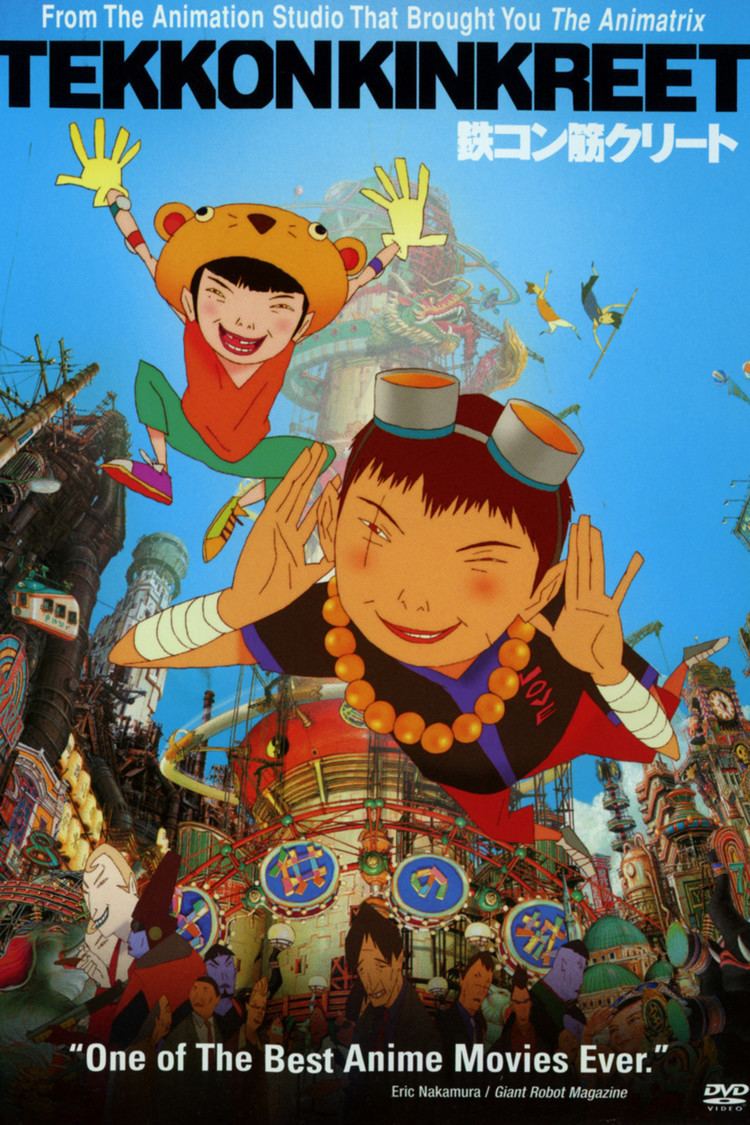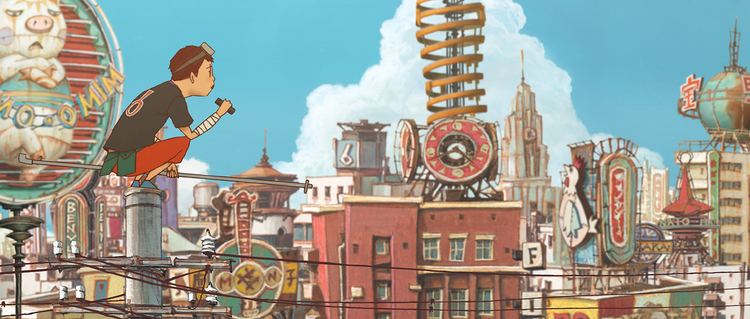7.6 /10 1 Votes
8.1/10 MyAnimeList Genre Drama, Adventure | 7.7/10 IMDb 72% Rotten Tomatoes | |||||||||||||||||||||||||||||||||
 | ||||||||||||||||||||||||||||||||||
Characters Shiro, Kuro, Suzuki aka Rat, Choco, Jiccha, Chinpira Cast Similar Manga movies, Anime movies, Animation | ||||||||||||||||||||||||||||||||||
Tekkonkinkreet subtitles trailer
Tekkonkinkreet (鉄コン筋クリート, Tekkonkinkurīto, a child's mispronunciation of "Tekkin Konkurito" [steel reinforced concrete]) is a three-volume seinen manga series by Taiyō Matsumoto, which was originally serialized from 1993 to 1994 in Shogakukan's Big Comic Spirits and first published in English as Tekkonkinkreet: Black & White. It was adapted into a 2006 feature-length Japanese anime film of the same name, directed by Michael Arias and animated by Studio 4°C. The film Tekkonkinkreet premiered in Japan on December 23, 2006.
Contents

The story takes place in the fictional city of Takaramachi (Treasure Town) and centers on a pair of orphaned street kids – the tough, canny Kuro (Black) and the childish, innocent Shiro (White), together known as the Cats – as they deal with yakuza attempting to take over Treasure Town.

Tekkonkinkreet 2006 trailer
Plot

While the manga follows multiple plot threads, the film adaption consists of a few plots shown in the manga.

The film follows two orphans, Kuro (クロ "Black") and Shiro (シロ "White"), as they attempt to keep control of the streets of the pan-Asian metropolis of Takaramachi, once a flourishing town and now a huge, crumbling slum fraught with warring between criminal gangs. Kuro is a violent and streetwise punk, considering Takaramachi to be "his town". Shiro is younger and appears to be mentally impaired, out of touch with the world around him and often living in a world of illusions. They call themselves "the Cats". Despite their extreme differences, they complement and support each other, similar to the Chinese Taoist principle of yin and yang.

During one of their "missions", they take on thugs and Kuro ends up beating up three Yakuza gang members who are menacing a street gangster friend of his. The Yakuza work for Snake (蛇), the head of a corporation called "Kiddy Kastle". Snake plans to tear down and rebuild Takaramachi as a theme park to fit his own goals and dreams. When Kuro interferes once too often, Yakuza are sent to kill him, but fail. Angered, Snake then sends the deadly "three assassins", near-superhuman hitmen, to finish the job.
In order to save Kuro and himself, Shiro has to kill the first assassin by tipping gasoline and setting it alight, burning him alive. The second assassin pursues Shiro and stabs him with a samurai sword. Shiro is then sent to the hospital. The police, who have been watching both Snake and the two youngsters, decide to take Shiro into protective custody "for his own good", while Kuro watches Shiro go knowing he would be too hard to look after while being hunted. Kuro later falls into a depressive state.
Alongside the children's narrative is a story is told through the eyes of Kimura (木村), an average man who gets caught up in the Yakuza, leading him to have a violent encounter with Kuro. Eventually, Kimura is forced by Snake to kill his former boss and mentor, Suzuki (鈴木), to remove possible competition. While Kimura fulfills his mission, he is deeply shocked by having murdered his mentor. Summoned once again by Snake, Kimura rebels and kills the Yakuza boss, before attempting to flee with his pregnant wife from Takaramachi. He is gunned down in a drive-by shooting by Snake's men.
While the police feel it is for the best for Shiro to remain with them outside Takaramachi, Shiro feels empty without Kuro there for support. In parallel, without Shiro, Kuro soon begins to lose grip on reality and allows his violence to consume him. He soon develops a split personality, with his dark side manifesting as the "minotaur". Things reach a climax when Shiro is brought back to Takaramachi by one of the officers and taken to a local fair. There, a delusional Kuro is trying to show people that "Shiro", in reality a mocked-up doll, has returned to life. When Kuro is attacked by Snake's two remaining assassins, the doll is damaged and Kuro flies into a murderous rage, killing the assassins. It is then that he is confronted by the real Shiro, and is forced to fight the "minotaur", who wishes to completely consume him. Kuro manages to triumph over his dark side and reunites with Shiro.
Manga
Tekkonkinkreet is a three-volume seinen manga series by Taiyō Matsumoto, which was originally serialized in Japan from 1993 to 1994 in Shogakukan's Big Comic Spirits and first published in English as Tekkonkinkreet: Black & White.
Film
All three manga issues were adapted into a 2006 feature-length Japanese anime film of the same name, directed by Michael Arias and animated by Studio 4°C. The film Tekkonkinkreet premiered in Japan on December 23, 2006.
The film featured the following cast:
"*" - Minor Role"**" - Not credited on the DVDReception
Joseph Luster, speaking on the film, felt that the brotherly bond between the protective Black and the endearing White was the heart of the manga. Chris Beveridge, writing in Mania, declared: "While it may not be what anime fans have come to expect for a traditional film, the end result is something that while predictable is surprisingly engaging." Chris Johnston of Newtype USA wrote: "Regardless of how much you watch this one, though, this is a film that no serious anime fan should miss.".
Awards
The manga won the 2008 Eisner Award for "Best U.S. Edition of International Material—Japan". Tekkonkinkreet won the "Best Film Award" at the 2006 Mainichi Film Awards. It was also named Barbara London's top film of 2006 in the annual "Best of" roundup by the New York Museum of Modern Art's Artforum magazine. In 2008, it received 'best original story' and 'best art direction' from the Tokyo International Anime Fair. It won the 2008 Japan Academy Prize for Animation of the Year.
